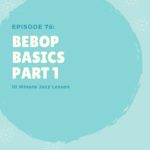 This week we are starting a multi-part series on what you should be doing to nail down the basics of the bebop style. Bebop is the most important thing to understand when it comes to playing modern jazz as the information provided by these revolutionary musicians informed all music that came after it.
This week we are starting a multi-part series on what you should be doing to nail down the basics of the bebop style. Bebop is the most important thing to understand when it comes to playing modern jazz as the information provided by these revolutionary musicians informed all music that came after it.
You can think of bebop as the building blocks for everything you will play and in this week’s episode we get into the must know exercises that come from the world famous musician and teacher, Barry Harris. I have chosen to compile some of his wisdom and present it to you in an easy to follow fashion. The important thing to remember in this episode is that I’m giving all of the exercises to you in C but you must transpose it into all 12 keys to get the full benefit. Have fun and enjoy this week’s episode!
WANT THE PDF THAT GOES ALONG WITH THIS EPISODE??
Head over to our Patreon page and when you donate $3 or more a month you get this PDF and every other. We will also be bringing you many extras exclusively to our patrons including transcriptions and a FREE gift of our latest Ebook, The Diatonic Method.
We hope that we bring you value every week here at the 10 Minute Jazz Lesson and we appreciate all of your support!
Podcast: Play in new window | Download
Subscribe: Apple Podcasts | RSS


Nick, there was no sound in the main (grey) screen. I did get audio in the smaller podcast window.
Oh no! Let me check into this. Thanks for the heads up!
Pay particular attention to where the chromatic approach note falls with relation to the down/up beat. Also note that the 3rd and 7th (in major) are diatonic approach notes to the next note, where as all others are chromatic.
Yes this. I recommend shifting where you start this in the measure so that all notes fall on all beats. Gives great flexibility. You’re right about those 2 diatonic notes, but they are also chromatic approaches that just happen to be diatonic as well.
Thanks for listening!
Excellence in instruction!!!!!